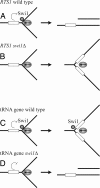Recombination at DNA replication fork barriers is not universal and is differentially regulated by Swi1
- PMID: 19273851
- PMCID: PMC2660728
- DOI: 10.1073/pnas.0807739106
Recombination at DNA replication fork barriers is not universal and is differentially regulated by Swi1
Abstract
DNA replication stress has been implicated in the etiology of genetic diseases, including cancers. It has been proposed that genomic sites that inhibit or slow DNA replication fork progression possess recombination hotspot activity and can form potential fragile sites. Here we used the fission yeast, Schizosaccharomyces pombe, to demonstrate that hotspot activity is not a universal feature of replication fork barriers (RFBs), and we propose that most sites within the genome that form RFBs do not have recombination hotspot activity under nonstressed conditions. We further demonstrate that Swi1, the TIMELESS homologue, differentially controls the recombination potential of RFBs, switching between being a suppressor and an activator of recombination in a site-specific fashion.
Conflict of interest statement
The authors declare no conflict of interest.
Figures




References
-
- Jefford CE, Irminger-Finger I. Mechanisms of chromosome instability in cancers. Crit Rev Oncol Hematol. 2006;59:1–14. - PubMed
-
- Aguilera A, Gómez-González B. Genome instability: A mechanistic view of its causes and consequences. Nature Reviews Genetics. 2008;9:204–217. - PubMed
-
- Weinstock DM, Richardson CA, Elliot B, Jasin M. Modeling oncogenic translocations: Distinct roles for double-strand break repair pathways in translocation formation in mammalian cells. DNA Repair. 2006;5:1065–1074. - PubMed
-
- Keeney S, Neale MJ. Initiation of meiotic recombination by formation of DNA double-strand breaks: Mechanism and regulation. Biochem Soc Trans. 2006;34:523–525. - PubMed
Publication types
MeSH terms
Substances
LinkOut - more resources
Full Text Sources
Molecular Biology Databases

